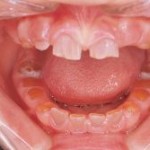Functional jaw orthpaedics is treatment with functional appliances making use of forces created by the head and neck musculature to bring about the desired dental, facial, and functional changes.
Functional appliances are removable or fixed [cemented] appliances that alter the posture of the mandible [lower jaw] and transmit the forces created by the resulting stretch of the muscles and soft tissues and by the change in the neuromuscular environment to the dental and skeletal tissues to produce movement of the teeth and modification to the growth of the jaws and lower face.
